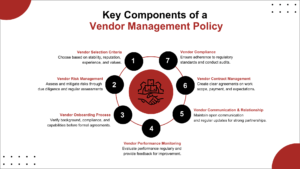Your Blueprint to Vendor Management Policy

Do you remember when KFC ran out of chicken in the UK? It sounds almost unbelievable, but this real-life incident perfectly illustrates the chaos that can ensue from poor vendor management. KFC had switched to a new delivery contractor, but the transition didn’t go as planned. Many of the chain’s outlets were forced to close temporarily due to supply issues. This high-profile failure (among many other such incidents happening frequently) underscores the importance of a robust Vendor Management Policy.
While many organizations have internal security policies, they often lack a comprehensive understanding of the risks associated with third-party vendors. This gap is particularly concerning given the increasing legal pressure companies are facing because of stricter regulatory compliance laws. These new standards mean organizations need a robust vendor management policy and to follow best practices now more than ever.
Regulatory bodies have identified third-party data breaches and leaks as significant cybersecurity risks. Consequently, there has been heightened regulatory scrutiny on third-party risk management frameworks, information risk management, and Vendor Risk Management (VRM), especially for vendors with access to personally identifiable information (PII).
The financial impact of data breaches can be significant, with the global average cost reaching USD 4.45 million in 2023, marking a 15% increase over recent years. A well-structured vendor management policy ensures that vendors are reliable and capable of meeting business demands, thereby preventing costly disruptions.
So, let’s discuss vendor management policy a bit more. We’ll cover its key components, how to create one, and how to use it to assess new vendors.
Understanding Vendor Management Policy
A Vendor Management Policy is a formal document outlining the processes, procedures, and guidelines for managing vendor relationships. It serves as a framework for evaluating, selecting, and monitoring vendors to ensure they meet the organization’s standards and requirements. The primary objective of a Vendor Management Policy is to mitigate risks associated with third-party engagements, such as compliance issues, financial instability, and performance inconsistencies.
Bonus Giveaway: Check out our blog post that clarifies the distinctions between vendors, suppliers, third-party, and fourth-party risks and sharpens your risk management strategy!
Benefits of a Vendor Management Policy
Implementing a comprehensive Vendor Management Policy offers several benefits:
- Enhanced Risk Management: A well-defined policy helps organizations identify and mitigate risks associated with third-party engagements. By conducting thorough risk assessments and implementing controls, organizations can minimize the impact of potential issues. According to a survey, 60% of companies are spending more money on improving vendor risk management, which would significantly reduce their overall risk exposure.
- Improved Vendor Performance: Monitoring and evaluating vendor performance ensures vendors consistently meet your organization’s standards and deliver high-quality products and services. This leads to improved operational efficiency and customer satisfaction.
- Cost Savings: Effective vendor management can result in significant cost savings by identifying opportunities for cost reduction, negotiating favorable terms, and preventing costly disruptions caused by vendor failures.
- Regulatory Compliance: A Vendor Management Policy helps organizations comply with regulatory requirements by setting clear compliance expectations for vendors and conducting regular audits to ensure adherence. This is particularly important in industries with stringent regulatory environments, such as healthcare and finance.
- Strengthened Vendor Relationships: Maintaining strong relationships with vendors through open communication and collaboration leads to better business outcomes and long-term partnerships. A positive vendor relationship can result in preferential treatment, such as priority access to new products or services.
Key Components of a Vendor Management Policy

- Vendor Selection Criteria: The first step in vendor management is selecting the right vendors. The criteria should include factors such as financial stability, reputation, experience, and alignment with the organization’s values and goals. For example, when Starbucks selects coffee bean suppliers, they prioritize ethical sourcing and sustainability over price. Their criteria include adherence to Coffee and Farmer Equity (CAFE) standards and Coffee Sourcing Guidelines (CSG), ensuring safe working conditions and no forced or child labor. Starbucks sources from nearly 30,000 coffee farms in Brazil, Colombia, and Kenya.
- Vendor Risk Management: A Vendor Risk Management outlines procedures for assessing and mitigating risks associated with vendors. This includes thorough due diligence, regular risk assessments, and implementing controls to address identified risks. For instance, pharmaceutical companies often conduct extensive background checks and risk assessments on suppliers to ensure compliance with regulatory standards.
- Vendor Onboarding Process: The vendor onboarding process ensures that new vendors meet the organization’s requirements before entering into a formal agreement. This process typically includes background checks, compliance verification, and a detailed review of the vendor’s capabilities and performance history. This helps prevent future issues and ensures vendors can meet company standards.
- Vendor Performance Monitoring: Continuous monitoring of vendor performance ensures they meet agreed-upon standards and deliverables. This involves regular evaluations, feedback mechanisms, and performance reviews to track effectiveness and identify areas for improvement.
- Vendor Compliance: Ensuring vendors comply with regulatory requirements and industry standards is crucial for mitigating legal and reputational risks. Vendor compliance involves setting clear expectations, conducting audits, and requiring vendors to adhere to relevant laws and regulations. The collapse of several high-profile companies due to non-compliance issues underscores the importance of rigorous vendor compliance.
- Vendor Contract Management: Effective vendor contract management ensures all vendor agreements are clearly defined and legally binding. This includes outlining the scope of work, payment terms, performance expectations, and termination clauses. Proper contract management helps prevent misunderstandings and disputes. For example, clear contracts with IT service providers can prevent disruptions in critical business operations.
- Vendor Communication and Relationship Management: Maintaining open and transparent communication with vendors is key to a successful partnership. Vendor communication and relationship management involve regular meetings, progress updates, and collaborative problem-solving to foster a positive working relationship.
Steps to Implement a Vendor Management Policy
Implementing a Vendor Management Policy involves several key steps:
- Define Objectives and Scope: Clearly define the objectives and scope of the policy. Identify the types of vendors covered, key risks to be managed, and desired outcomes. This provides a solid foundation for your vendor management efforts.
- Develop Policy and Procedures: Create a detailed policy document outlining the processes and procedures for vendor management. Include vendor selection criteria, risk management procedures, performance monitoring protocols, and compliance requirements. This ensures all aspects of vendor management are covered.
- Communicate Policy to Stakeholders: Ensure all relevant stakeholders, including employees, vendors, and regulatory bodies, know the policy and understand their roles and responsibilities. This can be achieved through training sessions, workshops, and regular communication.
- Implement Vendor Management Tools: Use vendor management tools and software to streamline the policy’s implementation and monitoring. These tools can automate risk assessments, performance evaluations, and compliance tracking processes, making vendor management more efficient and effective.
- Monitor and Review: Regularly monitor and review the policy’s effectiveness. Conduct periodic audits, gather stakeholder feedback, and make necessary adjustments to improve the policy. This ensures the policy remains relevant and effective over time.
Assess New Vendors with a 10-point Checklist
Use this checklist to ensure a comprehensive and effective vendor management policy that covers all critical aspects, from selection to ongoing relationship management.
- Vendor Selection Criteria
- ☐ Is the vendor financially stable?
- ☐ Does the vendor have a good reputation and relevant experience?
- ☐ Does the vendor align with our organization’s values and goals?
- ☐ Does the vendor adhere to specific standards (e.g., ethical sourcing)?
- Risk Management
- ☐ Has thorough due diligence been conducted on the vendor?
- ☐ Are regular risk assessments performed and controls in place?
- Onboarding Process
- ☐ Have background checks and compliance verification been completed?
- ☐ Does the vendor meet our organization’s requirements and standards?
- Performance Monitoring
- ☐ Is the vendor’s performance evaluated regularly and are feedback mechanisms in place?
- Compliance
- ☐ Are clear compliance expectations set and regular audits conducted?
- Contract Management
- ☐ Are the scope of work, payment terms, performance expectations, and termination clauses clearly defined?
- Communication
- ☐ Is there open, transparent communication with the vendor, including regular meetings and updates?
- Relationship Management
- ☐ Is collaborative problem-solving encouraged to maintain a positive relationship?
- Implementation Readiness
- ☐ Are the objectives, scope, and procedures for vendor management clearly defined and documented?
- Initial Policy Monitoring
- ☐ Is there a plan to monitor and review the vendor’s performance and compliance during the initial stages of the partnership?
To Download the Vendor Policy Management Checklist Click Here
iTech GRC: Leveraging IBM OpenPages for Vendor Management Policy
iTech GRC offers a comprehensive vendor management solution powered by IBM OpenPages, featuring advanced risk management and compliance tools. Key features include thorough risk assessments to identify and mitigate vendor risks, automated compliance tracking and reporting to ensure regulatory adherence, real-time performance monitoring to meet standards and deliverables, and a centralized repository for easy access to vendor information, contracts, and performance data. By utilizing iTech GRC with IBM OpenPages, organizations can streamline vendor management processes, enhance risk management, and ensure regulatory compliance.
If you need expert assistance to optimize your vendor management processes, reach out to our team.
Conclusion
A Vendor Management Policy is essential for organizations to manage their third-party relationships effectively. Organizations can mitigate risks, improve vendor performance, achieve cost savings, and ensure regulatory compliance by implementing a comprehensive policy.
How does your organization manage vendor relationships? Share your thoughts and experiences in the comments below!
